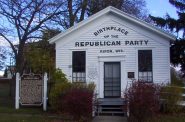The 10 Most Expensive State Programs
How does the state spend its money? And how might you change this?
Two weeks ago, this column provided numbers to let you design your own new tax code. It showed, for example, how you could lower personal income and property taxes by charging the 5 percent state sales tax on now-exempt goods and services.
This week, we’ll look at the other side of the ledger, spending by the state. Think of the general fund as state government’s main checkbook and you get to control it. You decide whether you like how state general-fund dollars were spent and, if you disagree with those priorities, how you would change them.
*No. 1: $5.14 billion in aid to K-12 schools, including public, charter and controversial Parents’ Choice/Voucher schools.
Context: Over the past five years, annual state aid to K-12 schools has ranged from $4.9 billion to $5.3 billion. That has Democrats charging that Republican Gov. Scott Walker and GOP legislators slashed funding for what should be the state’s top priority. But DOA fiscal reports for earlier years include this important caveat: Former Democratic Gov. Jim Doyle used $552 million in federal economic “stimulus” cash in fiscal 2009, and $236 million of those federal funds in 2010, to preserve aid to schools. Doyle used federal funds to protect school aids during the Great Recession.
*No. 2: $2.3 billion for health-care through the Medicaid program, which the federal government more than matched.
Context: A record 1.18 million residents – or one in five – now rely on Medicaid for health care, and the program costs more than $8 billion annually. Over the last five years, state Medicaid costs have more than doubled, rising from $1.13 billion to $2.3 billion. The state Department of Health Services has said it needs an additional $760 million in state funds to continue that coverage through mid-2017.
*No. 3: $1.16 billion to run prisons and other Department of Corrections programs.
Context: It cost 2.6 percent more to run prison, probation and parole programs last year, largely due to a 1 percent pay raise and overtime and health-care costs. Wisconsin’s prison population averaged 22,405 last year.
*No.4: $1.15 billion to fund the 26-campus University of Wisconsin System.
Context: This summer, Walker proposed a second round of two-year tuition freezes on UW campuses, starting in fall 2015. The UW Board of Regents, which sets policy for the system, says it needs $95 million more to offset that freeze.
*No. 5: $895 million to pay for tax credits that help offset property tax bills.
Context: Reduce these tax credits, and property tax bills go up.
*No. 6: $822 million in shared-revenue payments to local counties, cities, villages and towns.
Context: Dialing back state aid to local governments, while keeping tight controls on their property tax levies, could reduce local services.
*No. 7: $234 million for specific tax relief programs, including the Earned Income Tax Credit (EITC), $103 million; Homestead Tax Credit, $118 million; Veterans and Surviving Spouses Tax Credit , $23 million, and Farmland Preservation Credit , $19 million.
Context: Some of these programs are very popular; the EITC alone helped 267,500 low-income families.
*No. 8: $184 million in Community Aids to counties for programs that help the poor, children who need foster care and other protections, the elderly and disabled.
*No. 9: $150 million for the federal Supplemental Security Income program that helps low-income elderly, blind and disabled residents and parents of disabled children.
Although it doesn’t make the Top 10 list, state aid to technical colleges was about $110 million last year. Walker and Republican legislators want to also freeze technical college tuition for two years. But others say that could hurt tech colleges, if state government doesn’t make up money lost because of the tuition freeze.
These Top 10 programs total $14 billion – 84% of all general-fund spending last year. And aid to K-12 schools and Medicaid alone make up 51 percent of all spending.
Your turn. About $14.43 billion in general-fund taxes will be collected this year. How would you spend it?
Steven Walters is a senior producer for the non-profit public affairs channel WisconsinEye. Contact him at stevenscwalters@gmail.com
The State of Politics
-
RNC Brings Fame to Gen Z Party Leader
 Jul 15th, 2024 by Steven Walters
Jul 15th, 2024 by Steven Walters
-
Wisconsin’s Republican Roots Run Deep
 Jul 8th, 2024 by Steven Walters
Jul 8th, 2024 by Steven Walters
-
Feuding Supreme Court Justices Need a Break
 Jul 1st, 2024 by Steven Walters
Jul 1st, 2024 by Steven Walters





















Prisons #3. That is depressing.
I agree. Prison spending now exceeds spending on high education in the state.
Not that you care about the distinction, but Prison spending doesn’t exceed higher education spending. Unless you don’t consider the technical college spending to be “higher”.
I agree, the amount we spend on the prison system is alarming…
#5 and #7 are not expenses though… so what are “#11” and “#12” so we know what the true top 10 are? I suppose you can keep part of #7 on there because “refundable” tax credits are an expense when they go to a person who pays less in taxes then they get “refunded.”
I disagree with the use of the word “aid” for public school funding. Aid is something you give to foreign governments or for disaster relief. Public education is a federally protected service that the state must provide. Maybe if we didn’t phrase it as a hand out we would take more responsibility for the quality of the service we provide for ourselves.
Really liked this article. Unfortunately, because it’s only looking at GPR, it’s easy to miss the state’s overall spending picture. For example, the state is spending over $3 billion per year on transportation this biennium; because the Transportation Fund is financed as a proprietary account (via gas taxes and registration fees), we don’t see this very clearly on the GPR spending list. Also, once tuition (another proprietary funding source) and other intergovernmental revenues factor in, the state spends about $12 billion per biennium on the UW system, about 5x more than prisons… Would be interesting to compare GPR spending with total spending to see how the priorities change.
Glad to see someone mentioned transportation. Since there’s not $3bn in the Transportation Fund and it runs projected shortfalls on its own, I’m surprised to see that transfers to that fund don’t make this list. Maybe we haven’t started paying that credit card yet though.
@Kyle, Not that you care about the distinction, but Prison spending doesn’t exceed higher education spending.
Why wouldn’t I care Kyle?
Consider the prison spending amount when compared to our neighbor to the west – Minnesota spends half that amount and locks up half as many people (even though I believe they have more people on parole). And guess what – Minnesota isn’t overrun by violent criminals!
https://wistax.org/publication/the-cost-of-corrections-wisconsin-and-minnesota
#3 – That is disgusting. END THE WAR ON DRUGS. Not only will you save half that overnight, but you could EARN the same amount by taxing Weed.
You have a choice. There are 11 Libertarians on the ballot.
Robert Burke, Governor
Joe Brost, Lt Governor
Jerry Shidell Treasurer
Andrew Craig, Secretary of State
Tom Nelson, Attorney General
This election is crucial, the true issue being whether we are going to retain a constitutional republic, with limitations on the power of government at all levels, or continue down the road to an authoritarian socialist state. Do the Libertarians have any reasonable chance of getting elected? No, they don’t. Voting as a matter of principle is understandable, but when the potential problems from electing a ultra-liberal governor and other Democratic state officers is so great, it is also a wasted vote. We need the most conservative elected officials we can get, even if they do not agree with us on all issues. At least we can expect they will pay some attention to conservative voices. Burke et al will listen to nothing except the socialist agenda they support.
If any third party in this country wants to be heard, they will have to start at the grass roots level. Elect mayors and county officials, and then state legislatures. Build up a viable party structure, and then run for state level jobs. Running state candidates who cannot be elected only splits the conservative vote, and lets the liberals/progressives/socialists continue to push their Marxist agenda.
Wow perfect post for Halloween season. Socialism! Marxism! Authoritarianism! What a scary place that must be. Where is it?
thank Walker for not breaking the bank, like many states, by taking that exchange money and see it go up to a billion or so. Then the halfast train would have gone way over budget like Calif. did and finally, the worst one expanded Medicaid. We used Badger care and Obamcare to cover everyone so we had superior system and do not have to worry about the Feds renigging like the always do and going to 60% reimbursement and busting our school aids budget. UW system needs to be streamlined badly. They have feasted upon student loans putting many of these kids behind the eightball for 20 years when they get out. They have porkbarreld stupid courses and administration ancillary costs the last 40 years. it is criminal. It is nice to see the Left and Right agreeing on that.